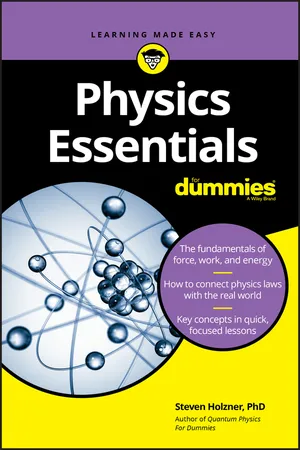
- English
- ePUB (mobile friendly)
- Available on iOS & Android
Physics Essentials For Dummies
About this book
Physics Essentials For Dummies (9781119590286) was previously published as Physics Essentials For Dummies (9780470618417). While this version features a new Dummies cover and design, the content is the same as the prior release and should not be considered a new or updated product.
For students who just need to know the vital concepts of physics, whether as a refresher, for exam prep, or as a reference, Physics Essentials For Dummies is a must-have guide. Free of ramp-up and ancillary material, Physics Essentials For Dummies contains content focused on key topics only. It provides discrete explanations of critical concepts taught in an introductory physics course, from force and motion to momentum and kinetics. This guide is also a perfect reference for parents who need to review critical physics concepts as they help high school students with homework assignments, as well as for adult learners headed back to the classroom who just need a refresher of the core concepts.
The Essentials For Dummies Series
Dummies is proud to present our new series, The Essentials For Dummies. Now students who are prepping for exams, preparing to study new material, or who just need a refresher can have a concise, easy-to-understand review guide that covers an entire course by concentrating solely on the most important concepts. From algebra and chemistry to grammar and Spanish, our expert authors focus on the skills students most need to succeed in a subject.
Frequently asked questions
- Essential is ideal for learners and professionals who enjoy exploring a wide range of subjects. Access the Essential Library with 800,000+ trusted titles and best-sellers across business, personal growth, and the humanities. Includes unlimited reading time and Standard Read Aloud voice.
- Complete: Perfect for advanced learners and researchers needing full, unrestricted access. Unlock 1.4M+ books across hundreds of subjects, including academic and specialized titles. The Complete Plan also includes advanced features like Premium Read Aloud and Research Assistant.
Please note we cannot support devices running on iOS 13 and Android 7 or earlier. Learn more about using the app.
Information
Viewing the World through the Lens of Physics




Figuring Out What Physics Is About
- Why do I slip when I try to climb that snow bank?
- What are those stars all about? Or are they planets? Why do they seem to move?
- What’s the nature of this speck of dust?
- Are there hidden worlds I can’t see?
- Why do blankets make me warm?
- What’s the nature of matter?
- What happens if I touch that high-tension line? (You know the answer to that one; as you can see, a little knowledge of physics can be a lifesaver.)
Paying Attention to Objects in Motion
Getting Energized
Moving as Fast as You Can: Special Relativity

Table of contents
- Cover
- Table of Contents
- Introduction
- Chapter 1: Viewing the World through the Lens of Physics
- Chapter 2: Taking Vectors Step by Step
- Chapter 3: Going the Distance with Speed and Acceleration
- Chapter 4: Studying Circular Motions
- Chapter 5: Push-Ups and Pull-Ups: Exercises in Force
- Chapter 6: Falling Slowly: Gravity and Friction
- Chapter 7: Putting Physics to Work
- Chapter 8: Moving Objects with Impulse and Momentum
- Chapter 9: Navigating the Twists and Turns of Angular Kinetics
- Chapter 10: Taking a Spin with Rotational Dynamics
- Chapter 11: There and Back Again: Simple Harmonic Motion
- Chapter 12: Ten Marvels of Relativity
- Index
- About the Author
- Advertisement Page
- Connect with Dummies
- End User License Agreement